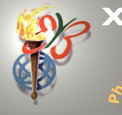| Select
a day
|
__
|
| |
|
Over 100 medals were awarded as little kids and big kids
alike shared the cool water of the olympic pool today. From
early in the morning until late in the afternoon, heat after
heat in many different events kept the water churned up. With
more than forty events broken into different age categories,
each team always had a few wet athletes, a few dry ones and
a few taking naps or eating snacks. The flags of dozens of
nations stood in a colorful row behind the gold, silver and
bronze medal winners' platforms. The platforms didn't get
much of a break as every few minutes more winners took their
places on the 1, 2 and 3 steps. Every group of medal recipients
was surrounded by an ever-present crowd of friends and family
with all manner of cameras.
Gabor Horvath was kind enough to tell me a bit more about
the building that houses the pools. A Hungarian hero, Alfred
Hajos, was the first Hungarian to ever win gold in the olympics.
His winning performance at the 1896 Athens Games brought gold
and fame in his home country. He then became an architect
and designed the Margit Island swimming facility which has
become known as Hungary's national pool. There is plenty of
room to hold an international event like the Transplant Games
and simultaneously accommodate diving lessons, water polo,
and recreational swimming.
The enthusiasm and pure pleasure in the faces of athletes
and families alike made this a terrific day at the pool. Rosters
of swimmers and events were pasted onto the brick wall of
the building and people kept looking for their names in order
to be sure to be ready when their events began. An orderly
procession of swimmers preceded the 25 meter events to the
south end of the pool so the the cheers of the crowd could
be heard as the races neared the finish on the north end of
the pool. After every event there were congratulations among
the fastest and slowest just going to prove that everyone
here is a winner!
|
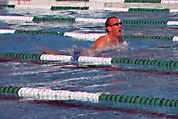
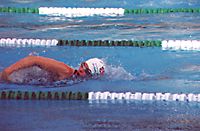
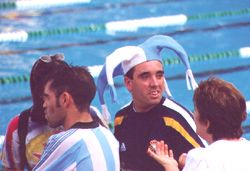
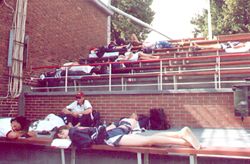
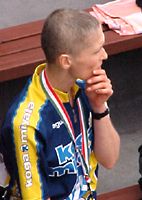
|
|
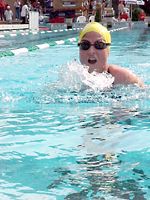
|
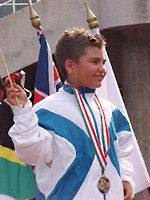
|
| The bicycling event at the XII World Transplant
Games took place on Csepel, a large island in the Danube (or
as the Hungarians say, Duna). |
|
|
As we approached the starting line (which also served as
the finish line), we saw bicyclists from all over the world,
in brightly colored attire, some with helmets, some without,
some warming up by bicycling around the street where the event
was to start, others doing last minute checks on their two-wheeled
steeds. There were some pretty serious, expensive bikes, and
some that were less so.
Over the rock music playing on the sound system I could hear
riders speaking in Italian, French, Australian English, British
English, Swedish, Finnish, German, and of course Hungarian.
|
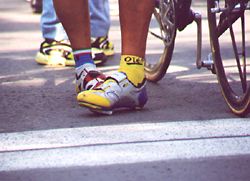
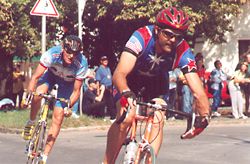
|
| In fact, there were 57 bicyclists in all, from
seventeen different countries; of these, only six were women.
The youngest competitor was seventeen. |
|
| The start of the race was somewhat delayed due to the late
arrival of the truck with some of the bicycles, causing some
of the riders a bit of anxiety. One rider who had more than
a little trouble with his bike was Australian Mark Dinnar, whose
bike was completely ruined in a car crash a few days ago here
in Budapest. Although he suffered bruises and a few minor injuries,
Mark was still quite game to ride today, and did so on a bike
loaned by one of the sponsors. |
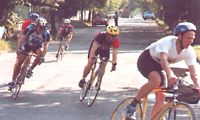 |
| With lots of cheers and shouts, the three races
began in succession, and bikers were quickly out of sight. What
followed was a bit confusing for most concerned. As I understand
it from the bronze medalist, Great Britain's Richard Smith,
those who were right in front, directly behind the motorcyclist
leading the race, had no trouble following the course. But those
who fell behind soon lost sight of the motorcyclist and found
themselves somewhat lost, uncertain of where the course was,
and on streets that didn't seem to be closed to motor vehicles.
One of the women came biking toward the finish line and as the
crowd began to cheer (thinking she was finishing, having completed
the two laps). But she said "I'm not done, I'm LOST!" |
|
| Luckily, it was possible to run the race again, to give those
who wanted to complete the course the opportunity to do so,
which went a long way towards satisfying the cyclists. |
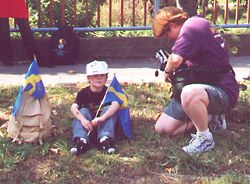 |
|
|
